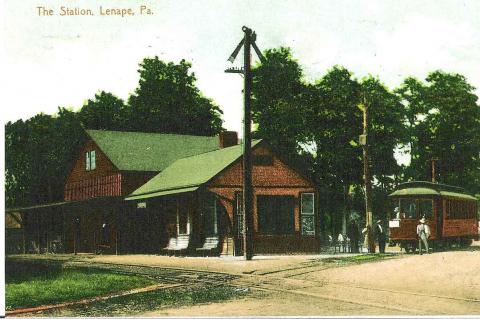Trolleys
The West Chester Street Railway organized in 1890 and began operation in that borough by September of 1891. Almost simultaneously, a route to Lenape was being graded and by November of 1891 the first trip to Lenape was accomplished. The trip was 4.2 miles and took about 25 minutes first along Sconnelltown Road, open countryside, and what is now the area of soccer fields in East Bradford Township. It ran at a speed of 7 mph and cost 5 cents.
The trolley ran through what is now the main parking lot of the Brandywine Picnic Park, up to the bridge across the Brandywine, to a small station of the Wilmington & Northern Railroad. A stone wall can still be seen at the southern end of the arched bridge when the trolley entered the roadway.
Initially, a small car was used, but by 1892 a forty-passenger car was placed in service. In 1891, the control of the West Chester Street Railway passed to William M. Hayes, former counsel for the Wilmington & Northern Railroad. He proposed the construction of Lenape Park by the trolley company to encourage more ridership. This was constructed on a triangular piece of land between the trolley route and the Brandywine Creek. Additional cars were used during the summer months. A dance hall was eventually built on the other side of the Brandywine behind the railroad station. This structure is now in disrepair. The new park soon caused the demise of the Birmingham Park about 1 ½ miles south on the east side of the Brandywine in Birmingham Township (in the floodplain near the intersection of Meetinghouse Road and Creek Road). This park had been built by the railroad in the 1870’s.
A small baggage car was often attached to the passenger cars so goods could be sent to Lenape to be transferred to the railroad for shipment to Wilmington. At first, the line terminated at Lenape but, by the end of 1904, it was extended to the Kennett Square Borough line. The initial arrangements at the Lenape transfer point would strike the modern reader as cumbersome. Passengers wishing to proceed beyond Lenape would have to get off the West Chester trolley car, walk across the railroad tracks and board a small, four-wheel shuttle car, which would take them as far as Unionville by July of 1904. The end of 1904 saw the installation of an electric signal at Lenape, which allowed through service with stops in Pocopson Township at Lenape, Barnard Station (opposite what is now Pocopson Home), and Haines’ Mill.
A power house was built to support the extended line and improve the unreliable electric supply to Lenape. This building is now the older brick portion of the Lenape Forged Products structure at Route 52 & Pocopson Road.
 The Kennett line ran along the south side of present-day route 52, past the old Lenape Schoolhouse, and along Lenape-Unionville Road. Along this road it is easy to see the graded route on the south side of the roadway. There are also several small bridge abutments where the trolley tracks passed over small streams. There were several small sidings along the way to allow cars to pass.
The Kennett line ran along the south side of present-day route 52, past the old Lenape Schoolhouse, and along Lenape-Unionville Road. Along this road it is easy to see the graded route on the south side of the roadway. There are also several small bridge abutments where the trolley tracks passed over small streams. There were several small sidings along the way to allow cars to pass.
The trolley connection to the railroad at Lenape allowed passengers to ride from West Chester to Wilmington, but the connection didn’t always prove accommodating. One frequent rider complained in 1919 that, if he wished to go to Wilmington by the 10:19 train from Lenape, he had to take the 9 o’clock trolley from West Chester and wait an hour at Lenape. If he took the 10 o’clock trolley instead, he’d all too often arrive at Lenape to see the train just leaving the station. Connections for the return trip were even worse, he wrote, because the inevitable wait would be outdoors, regardless of the weather, after the station closed.
The Kennett Line connected south to Yorklyn and eventually to Wilmington. It also extended west to West Grove. The West Chester Borough system connected to Philadelphia to the east and as far as Harrisburg to the west via Downingtown, Coatesville, Parkesburg, and Lancaster with stops along the way.
As cars and busses became more popular and the roads improved, the trolley system in this area and west declined. The trolley ceased operation in 1929.
On the last day of operation of the Lenape line a trolley broke an axel causing a long delay for passengers. On the bright side of the demise was the rise of bus companies owned by the trolley company to service the same areas.
| Attachment | Size |
|---|---|
| 361.92 KB |

